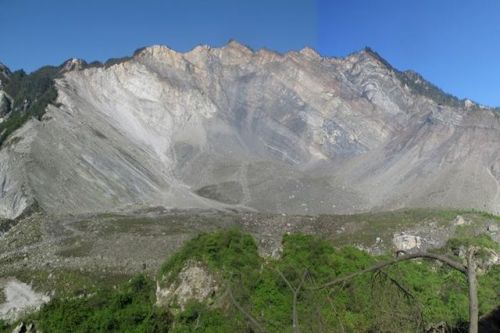
FYFD
Celebrating the physics of all that flows. Ask a question, submit a post idea or send an email. You can also follow FYFD on Twitter and YouTube. FYFD is written by Nicole Sharp, PhD.
If you're a fan of FYFD and would like to help support the site and its outreach, please consider becoming a patron on Patreon or giving a donation through PayPal with the button below. Your support is much appreciated!
In 2008, an 8.2 magnitude earthquake in China caused the enormous Daguangbao landslide, which loosed over one cubic kilometer of rocks and debris. That material rushed down the mountainside, running more than 4 kilometers before coming to a stop. A new study uses field measurements and laboratory experiments to explain how the landslide could run so far from its source.
The researchers found that friction between the sliding material and the stable rock heated that layer to over 850 degrees Celsius, hot enough to start decomposing the dolomite in the fall. That vaporized carbon dioxide out of the rock, which helped lower the friction. Simultaneously, the high temperatures and high pressures within in the landslide caused recrystallization in the falling rocks; this created a viscous layer that helped lubricate the slide. The team estimated that the two mechanisms working in tandem enabled the landslide to reach an estimated 60 m/s. (Image and research credit: W. Hu et al.; via Nature; submitted by Kam-Yung Soh)
You’ve seen it a million times. When you turn on your kitchen faucet, the falling water forms a distinctive ring – known as a hydraulic jump – in the bottom of your sink. First described by Leonardo da Vinci, this phenomenon has been studied for centuries, and, for nearly all of that time, scientists assumed that gravity played a major role, even in kitchen-sink-sized hydraulic jumps. But that’s not the case.
A newly published study shows that gravity can’t be a major player in setting the radius of these small-scale hydraulic jumps because they form the same whether the jet impinges from above, below, or sideways. Instead, the researchers found that surface tension and viscosity are the parameters that determine the jump’s formation. It’s not every day that you get to overturn a centuries-old theory in physics! (Image credit: J. Kilfiger; research credit: R. Bhagat et al.; via Silicon Republic; submitted by Patrick D.)
Supercritical fluids are neither a gas nor a liquid. The video above shows a tube of pressurized xenon, initially below its boiling point of approximately ~16 deg C. As the temperature is raised, you see the meniscus that marks the liquid xenon disappear. At this point, the xenon has transitioned into the supercritical state. It takes up the entire tube – like a gas – but it is still capable of dissolving materials – like a liquid. At the same time, though, the xenon has no surface tension because there’s no liquid/vapor interface. Toward the end of the video, the temperature gets reduced and the xenon condenses back into a liquid state. Supercritical fluids can be used in a wide variety of industrial applications, including in decaffeination, dry cleaning, and refrigeration. (Video credit: wwwperiodictableru)
One of the factors that complicates geophysical flows is that both the atmosphere and the ocean are stratified fluids with many stacked layers of differing densities. These variations in density can generate instabilities, trap rising or sinking fluids, and transmit waves. The animations above show flow over two ridges with dye visualization (top), velocity (middle), and contours of density (bottom). The upstream influence of the left ridge creates a smooth, focused flow that quickly becomes turbulent after the crest. The jet rebounds as a turbulent hydraulic jump before slowing again upstream of the second ridge. Like the first ridge, the second ridge also generates a hydraulic jump on the lee side. Clearly both stratification and the local topography play a big role in how air moves over and between the ridges. If prevailing winds favor these kinds of flows, it can help generate local microclimates. (Image credit and submission: K. Winters, source videos)
Supercritical fluids exist at temperatures and pressures above the critical point, in a region of the phase diagram where there is no clear boundary between the liquid and gaseous state. Supercritical fluids have some of the properties of each state: they can move as freely as a gas, but they are still capable of dissolving materials like a liquid does. They also have no surface tension because there is no interface between liquid and solid. These properties make supercritical fluids very useful in industrial applications, including decaffeination and chemical deposition. Interestingly, the temperatures and pressures on Venus are so high that scientists think the atmosphere at the surface is a supercritical fluid. (Video credit: SCFED Project)
A supercritical fluid exists without a distinct liquid or gas phase and forms when temperatures and pressures exceed the substance’s critical point. Here supercritical transition is demonstrated with an ampule of liquid chlorine. When immersed in a hot bath, the temperature and pressure inside the ampule rises until around 0:20 when the meniscus marking the interface between liquid and gas disappears. The chlorine is now in its supercritical state. Around 0:43 the hot bath is removed and the chlorine begins to cool, reverting to distinct phases of matter around 0:55.
Supercritical fluids live in the region of a phase diagram beyond the critical point. At these temperatures and pressures, a substance is neither strictly liquid nor a gas but exhibits behaviors from both. A supercritical fluid can effuse through a solid like a gas does but can also dissolve substrates like a liquid. As noted in the video above, supercritical fluids are useful substitutes for organic solvents in many industrial applications. Carbon dioxide, for example, is used as a supercritical fluid in the decaffeination process.
It’s Tuesday again! If you enjoy this blog, please take a moment to recommend us in the Tumblr directory. Thanks!

